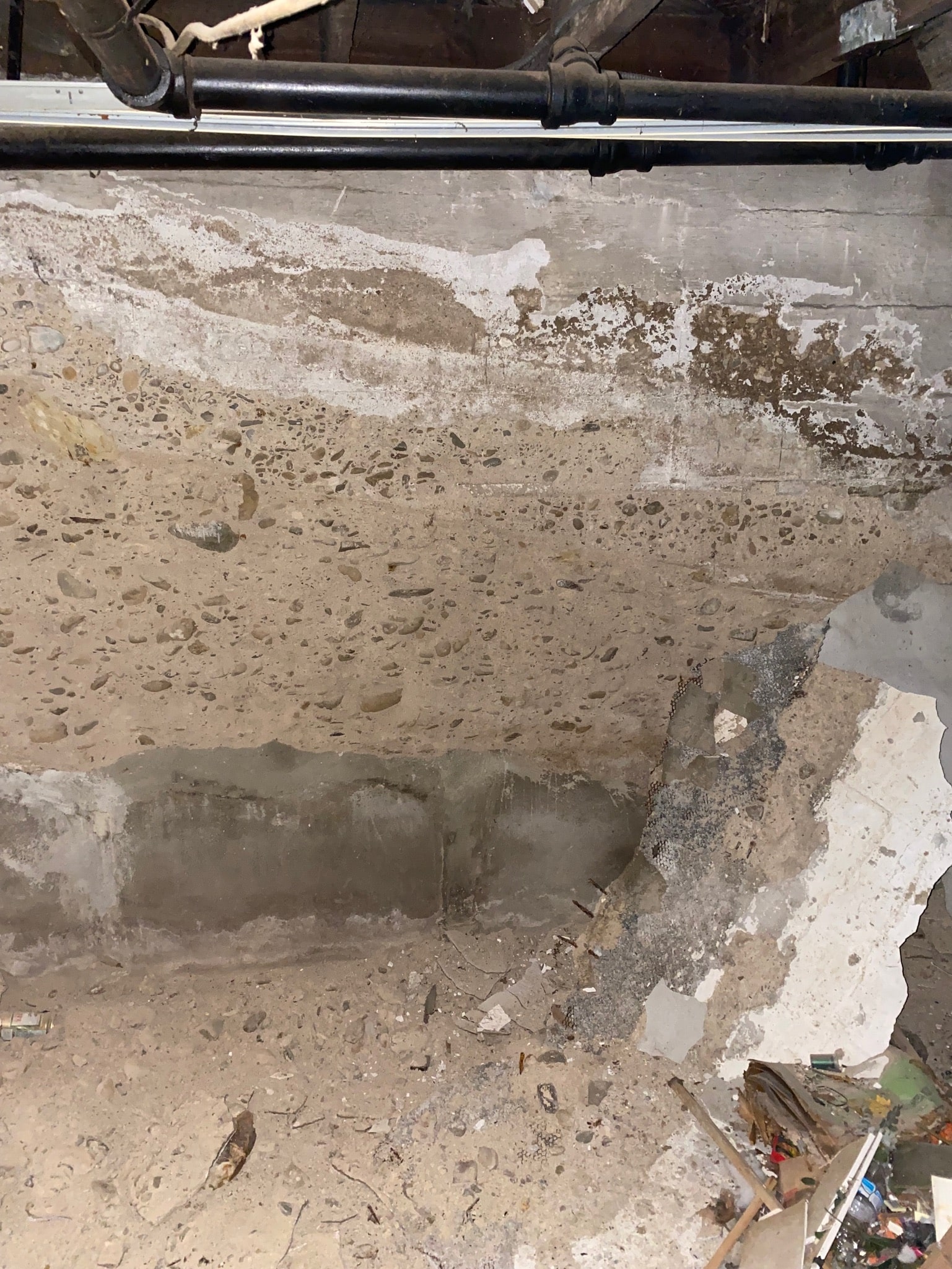
You’re walking around the exterior of your home or checking the basement, and suddenly notice a crack in your foundation that seems to follow a zig-zag pattern through the mortar joints of your concrete block wall. This type of damage, known as a stair-step crack, isn’t random. It’s a red flag that our foundation is under stress.
Stair-step cracks are among the most common and most telling signs of foundation trouble. Depending on their size, location, and behavior over time, they can indicate anything from minor settling to serious structural movement that requires immediate intervention.
In this article, we’ll explain what stair-step cracks mean, what causes them, how to evaluate their severity, and the repair strategies that can stop the damage before it escalates.
🔑 Key Takeaways
- Stair-step cracks form along mortar joints in block or brick foundation walls.
- They typically indicate differential settlement or lateral soil pressure.
- These cracks may widen, shift, or leak water over time.
- Solutions include wall anchors, carbon fiber reinforcement, and pier systems.
- Early repair prevents bowing walls, water intrusion, and major structural damage.
What Are Stair-Step Cracks?
A stair-step crack is a pattern of cracking that follows the mortar joints in a zig-zag or “step-like” fashion through a brick or block wall. Unlike vertical cracks, these cracks suggest that a portion of the foundation is moving unevenly — typically settling lower than the surrounding sections.
What Causes Stair-Step Cracks?
1. Differential Settlement
The most common cause. When one part of the foundation sinks more than another — due to poor soil compaction, moisture imbalance, or expansive soils — stress builds, and cracks follow the path of least resistance: the mortar joints.
2. Hydrostatic Pressure
Saturated soil around the foundation creates lateral pressure. Over time, this pressure can push walls inward, especially in basement walls, causing stair-step cracking and bowing.
3. Poor Construction or Lack of Reinforcement
Foundations built without adequate steel reinforcement or proper footing support are more susceptible to cracking as they age or shift.
4. Frost Heave
In colder climates, soil expands when it freezes. This can push sections of the foundation upward or inward, resulting in stair-step cracking patterns.
5. Plumbing Leaks or Excess Moisture
Chronic leaks around or beneath the foundation change the moisture content of the surrounding soil, causing it to expand or contract unevenly — contributing to movement and cracking.
How to Evaluate a Stair-Step Crack
Not all cracks require immediate repair, but it’s important to understand which ones do. Here’s how to evaluate their severity:
| Crack Feature | What It Suggests |
|---|---|
| Hairline width, no movement | Likely shrinkage or early-stage settlement. |
| Wider than 1/8 inch | Active foundation movement. |
| Widening over time | Progressing settlement or pressure. |
| Displacement between blocks | Structural shift — higher risk of wall failure. |
| Water leaking through crack | Hydrostatic pressure is breaching the wall. |
| Visible bowing in the wall | Critical — wall reinforcement is needed. |
If you notice a combination of these, especially widening or movement, don’t wait, call a professional for evaluation.
Related Signs to Watch For
If you see stair-step cracks, check for other warning signs of foundation distress:
- Cracks around windows and doors
- Interior drywall is cracking at the corners
- Sloping floors
- Doors and windows that won’t close properly
- Water intrusion at the base of the wall
- Gaps between walls and floor or ceiling
These symptoms together point to more than a cosmetic issue — they suggest the foundation is shifting.
Why Ignoring Stair-Step Cracks Is Risky
Structural Weakening
Cracks compromise the integrity of block and brick walls, making them less resistant to external pressure and weight loads.
Moisture Intrusion
Even small cracks can allow water into your basement or crawlspace, leading to:
- Mold and mildew
- Rotting framing materials
- Damaged insulation or finishes
- Poor indoor air quality
Bowing or Collapsing Walls
If cracking is due to soil pressure, the wall may continue to bow inward — eventually becoming structurally unstable or even collapsing.
Increased Repair Costs
What starts as a relatively simple fix can become a major repair project if the damage spreads or deepens.
How Professionals Repair Stair-Step Cracks
1. Crack Injection (For Minor, Stable Cracks)
- Method: Epoxy or polyurethane injection into cracks to seal against water and restore wall integrity.
- Best for: Hairline to 1/8″ cracks with no wall movement.
2. Carbon Fiber Reinforcement
- Method: High-strength carbon fiber straps bonded to the interior wall.
- Purpose: Stabilizes and reinforces walls showing early signs of bowing or cracking.
- Best for: Non-displaced walls with minor movement.
3. Wall Anchors
- Method: Anchors are installed in stable soil outside the foundation and connected to steel plates inside.
- Purpose: Pulls and holds the wall in place, gradually correcting inward bowing.
- Best for: Moderate wall movement due to lateral soil pressure.
4. Steel I-Beam Reinforcement
- Method: Vertical I-beams are mounted against the wall and braced from floor to ceiling.
- Purpose: Provides rigid support for severely bowing or cracked walls.
- Best for: Displaced or critically weakened walls.
5. Foundation Piering (If Settlement Is the Cause)
- Method: Helical or push piers are driven into stable soil to lift and support the foundation.
- Purpose: Stops vertical settlement and prevents further movement.
- Best for: Stair-step cracks caused by sinking or uneven foundation support.
6. Drainage Solutions
- Method: Regrade the yard, extend downspouts, or install French drains and sump pumps.
- Purpose: Prevents future water buildup and pressure that contributes to cracking.
Real-Life Example: Reversing the Steps
A homeowner in Botetourt County, VA, noticed a stair-step crack forming on the rear basement wall. Over several months, it widened and began to seep water during storms. The interior drywall near the same wall also developed a diagonal crack.
Seal-Tite Basement Waterproofing inspected the property and found:
- Evidence of lateral soil pressure from poor yard grading
- A slight inward bowing of the wall
- Saturated clay soil creating hydrostatic pressure
Solution Provided:
- Wall anchors were installed to stabilize and gradually straighten the wall
- Cracks were sealed with epoxy injection
- Yard was regraded and downspouts extended to redirect water
The homeowner avoided a full wall rebuild and gained long-term peace of mind.
FAQs: Stair-Step Cracks
Are stair-step cracks always serious?
Not always — but they often indicate foundation movement. Even if small, they should be monitored and professionally evaluated.
Can I just patch over the crack?
Surface patching hides the crack but doesn’t stop the underlying problem. Structural or drainage issues must be addressed to prevent worsening.
How much does it cost to repair stair-step cracks?
It depends on severity. Sealing minor cracks may cost a few hundred dollars. Reinforcement systems like anchors or I-beams can range from $2,000 to $10,000 or more.
Do I need to excavate around the home?
Not necessarily. Many wall reinforcements and waterproofing solutions can be installed from inside the basement.
Will this affect my home’s value?
If addressed properly and documented, repairs can preserve or restore your home’s value. Ignoring visible cracks, however, can reduce resale appeal.
Conclusion: Don’t Let Stair-Step Cracks Become a Downward Spiral
Stair-step cracks might seem minor at first glance, but they’re often your foundation’s way of signaling deeper problems. Whether caused by shifting soil, excess moisture, or structural overload, these cracks deserve professional attention.
The good news? With modern repair techniques and experienced guidance, you can stop the damage in its tracks — and reinforce your home for the future.
If you’ve noticed stair-step cracks in your foundation walls, contact Seal-Tite Basement Waterproofing today. Our team will assess the cause, explain your options, and deliver a long-term solution that keeps your foundation strong and secure.

Seal-tite Basement Waterproofing Co. is a full service basement environment contractor. We carry an A+ Better Business Bureau rating. We repaired over 40,000 homes and structures in Virginia, West Virginia, Tennessee, and North Carolina. We are fully insured and licensed. We have worked in all types of locations, including residential and commercial locations, government agencies, colleges, hospitals, churches, and condo associations.
Seal-tite® offers a lifetime transferable warranty. We carry a Class A Contractor’s License and we are fully insured. Our satisfied customers range from government agencies to businesses, hospitals, colleges, churches, and thousands of homeowners. Your home is probably the single largest investment you will make in your lifetime. Don’t wait, call Seal-tite® to help make your home dry, safe and livable.

